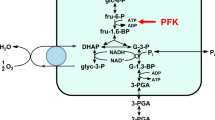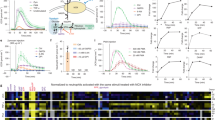Abstract
Trypanosoma brucei is the causative agent of African sleeping sickness. Available treatments are ineffective, toxic and susceptible to resistance by the parasite. Here we show that various endogenous neuropeptides act as potent antitrypanosome agents. Neuropeptides exerted their trypanolytic activity through an unusual mechanism that involves peptide uptake by the parasite, disruption of lysosome integrity and cytosolic accumulation of glycolytic enzymes. This promotes an energetic metabolism failure that initiates an autophagic-like cell death. Neuropeptide-based treatment improved clinical signs in a chronic model of trypanosomiasis by reducing the parasite burden in various target organs. Of physiological importance is the fact that hosts respond to trypanosome infection producing neuropeptides as part of their natural innate defense. From a therapeutic point of view, targeting of intracellular compartments by neuropeptides suppose a new promising strategy for the treatment of trypanosomiasis.
Similar content being viewed by others
Log in or create a free account to read this content
Gain free access to this article, as well as selected content from this journal and more on nature.com
or
Abbreviations
- AM:
-
adrenomedullin
- apo-L1:
-
apolipoprotein-1
- BSF:
-
bloodstream forms
- FAM:
-
carboxifluorescein
- PCF:
-
procyclic forms
- PGK:
-
phosphoglycerate kinase
- UCN:
-
urocortin
- VIP:
-
vasoactive intestinal peptide
- VSG:
-
variant surface glycoprotein
References
Barrett MP, Burchmore RJ, Stich A, Lazzari JO, Frasch AC, Cazzulo JJ et al. The trypanosomiases. Lancet 2003; 362: 1469–1480.
Legros D, Ollivier G, Gastellu-Etchegorry M, Paquet C, Burri C, Jannin J et al. Treatment of human African trypanosomiasis: present situation and needs for research and development. Lancet Infect Dis 2002; 2: 437–440.
Zasloff M . Antimicrobial peptides of multicellular organisms. Nature 2002; 415: 389–395.
Huang HW . Molecular mechanism of antimicrobial peptides: the origin of cooperativity. Biochim Biophys Acta 2006; 1758: 1292–1302.
Souto-Padron T . The surface charge of trypanosomatids. An Acad Bras Cienc 2002; 74: 649–675.
Haines LR, Hancock RE, Pearson TW . Cationic antimicrobial peptide killing of African trypanosomes and Sodalis glossinidius, a bacterial symbiont of the insect vector of sleeping sickness. Vector Borne Zoonotic Dis 2003; 3: 175–186.
McGwire BS, Olson CL, Tack BF, Engman DM . Killing of African trypanosomes by antimicrobial peptides. J Infect Dis 2003; 188: 146–152.
Charnley M, Moir AJ, Douglas CW, Haycock JW . Anti-microbial action of melanocortin peptides and identification of a novel X-Pro-d/l-Val sequence in Gram-positive and Gram-negative bacteria. Peptides 2008; 29: 1004–1009.
Allaker RP, Grosvenor PW, McAnerney DC, Sheehan BE, Srikanta BH, Pell K et al. Mechanisms of adrenomedullin antimicrobial action. Peptides 2006; 27: 661–666.
Brickman MJ, Balber AE . Trypanosoma brucei rhodesiense: membrane glycoproteins localized primarily in endosomes and lysosomes of bloodstream forms. Exp Parasitol 1993; 76: 329–344.
Opperdoes FR . Compartmentation of carbohydrate metabolism in trypanosomes. Annu Rev Microbiol 1987; 41: 127–151.
Dunn Jr WA . Studies on the mechanisms of autophagy: maturation of the autophagic vacuole. J Cell Biol 1990; 110: 1935–1945.
Merkel P, Beck A, Muhammad K, Ali SA, Schonfeld C, Voelter W et al. Spermine isolated and identified as the major trypanocidal compound from the snake venom of Eristocophis macmahoni causes autophagy in Trypanosoma brucei. Toxicon 2007; 50: 457–469.
Alvarez VE, Kosec G, Sant’Anna C, Turk V, Cazzulo JJ, Turk B . Autophagy is involved in nutritional stress response and differentiation in Trypanosoma cruzi. J Biol Chem 2008; 283: 3454–3464.
Herman M, Gillies S, Michels PA, Rigden DJ . Autophagy and related processes in trypanosomatids: insights from genomic and bioinformatic analyses. Autophagy 2006; 2: 107–118.
Docampo R, Moreno SN . Current chemotherapy of human African trypanosomiasis. Parasitol Res 2003; 90: S10–S13.
Burri C, Brun R . Eflornithine for the treatment of human African trypanosomiasis. Parasitol Res 2003; 90: S49–S52.
Gonzalez-Rey E, Delgado M . Anti-inflammatory neuropeptide receptors: new therapeutic targets for immune disorders? Trends Pharmacol Sci 2007; 28: 482–491.
McGwire BS, Olson CL, Tack BF, Engman DM . Killing of African trypanosomes by antimicrobial peptides. J Infect Dis 2003; 188: 146–152.
Boulanger N, Brun R, Ehret-Sabatier L, Kunz C, Bulet P . Immunopeptides in the defense reactions of Glossina morsitans to bacterial and Trypanosoma brucei brucei infections. Insect Biochem Mol Biol 2002; 32: 369–375.
Luque-Ortega JR, Van’t Hof W, Veerman EC, Saugar JM, Rivas L . Human antimicrobial peptide histatin 5 is a cell-penetrating peptide targeting mitochondrial ATP synthesis in Leishmania. FASEB J 2008; 22: 1817–1828.
Mehlert A, Zitzmann N, Richardson JM, Treumann A, Ferguson MA . The glycosylation of the variant surface glycoproteins and procyclic acidic repetitive proteins of Trypanosoma brucei. Mol Biochem Parasitol 1998; 91: 145–152.
Acosta-Serrano A, Vasella E, Liniger M, Kunz Renggli C, Brun R, Roditi I et al. The surface coat of procyclic Trypanosoma brucei: programmed expression and proteolytic cleavage of procyclin in the tsetse fly. Proc Natl Acad Sci USA 2001; 98: 1513–1518.
Field MC, Carrington M . Intracellular membrane transport systems in Trypanosoma brucei. Traffic 2004; 5: 905–913.
Magez S, Geuskens M, Beschin A, del Favero H, Verschueren H, Lucas R et al. Specific uptake of tumor necrosis factor-alpha is involved in growth control of Trypanosoma brucei. J Cell Biol 1997; 137: 715–727.
Perez-Morga D, Vanhollebeke B, Paturiaux-Hanocq F, Nolan DP, Lins L, Homble F et al. Apolipoprotein L-I promotes trypanosome lysis by forming pores in lysosomal membranes. Science 2005; 309: 469–472.
Blattner J, Helfert S, Michels P, Clayton C . Compartmentation of phosphoglycerate kinase in Trypanosoma brucei plays a critical role in parasite energy metabolism. Proc Natl Acad Sci USA 1998; 95: 11596–11600.
Kessler PS, Parsons M . Probing the role of compartmentation of glycolysis in procyclic form Trypanosoma brucei: RNA interference studies of PEX14, hexokinase, and phosphofructokinase. J Biol Chem 2005; 280: 9030–9036.
Besteiro S, Williams RA, Coombs GH, Mottram JC . Protein turnover and differentiation in Leishmania. Int J Parasitol 2007; 37: 1063–1075.
Herman M, Pérez-Morga D, Schtickzelle N, Michels PA . Turnover of glycosomes during life-cycle differentiation of Trypanosoma brucei. Autophagy 2008; 4: 294–308.
Bera A, Singh S, Nagaraj R, Vaidya T . Induction of autophagic cell death in Leishmania donovani by antimicrobial peptides. Mol Biochem Parasitol 2003; 127: 23–35.
Besteiro S, Williams RA, Morrison LS, Coombs GH, Mottram JC . Endosome sorting and autophagy are essential for differentiation and virulence of Leishmania major. J Biol Chem 2006; 281: 11384–11396.
Brogden KA, Guthmiller JM, Salzet M, Zasloff M . The nervous system and innate immunity: the neuropeptide connection. Nat Immunol 2005; 6: 558–564.
Summers MA, O’Dorisio MS, Cox MO, Lara-Marquez M, Goetzl EJ . A lymphocyte-generated fragment of vasoactive intestinal peptide with VPAC1 agonist activity and VPAC2 antagonist effects. J Pharmacol Exp Ther 2003; 306: 638–645.
Debrabant A, Lee N, Bertholet S, Duncan R, Nakhasi HL . Programmed cell death in trypanosomatids and other unicellular organisms. Int J Parasitol 2003; 33: 257–267.
Debrabant A, Nakhasi H . Programmed cell death in trypanosomatids: is it an altruistic mechanism for survival of the fittest? Kinetoplastid Biol Dis 2003; 2: 7.
Acknowledgements
We thank PA Michels and V Hannaert (Université Catholique de Louvain) and JD Bangs (University of Wisconsin Medical School) for providing invaluable antibodies for glycosome and lysosomal proteins. This study was supported by Spanish Ministry of Education and Science, FIS and RETICS.
Author information
Authors and Affiliations
Corresponding author
Additional information
Edited by M Piacentini
Supplementary Information accompanies the paper on Cell Death and Differentiation website (http://www.nature.com/cdd)
Rights and permissions
About this article
Cite this article
Delgado, M., Anderson, P., Garcia-Salcedo, J. et al. Neuropeptides kill African trypanosomes by targeting intracellular compartments and inducing autophagic-like cell death. Cell Death Differ 16, 406–416 (2009). https://doi.org/10.1038/cdd.2008.161
Received:
Revised:
Accepted:
Published:
Issue date:
DOI: https://doi.org/10.1038/cdd.2008.161
Keywords
This article is cited by
-
Cell death pathways in pathogenic trypanosomatids: lessons of (over)kill
Cell Death & Disease (2019)
-
Microbiota and gut neuropeptides: a dual action of antimicrobial activity and neuroimmune response
Psychopharmacology (2019)
-
Enteroendocrine cells-sensory sentinels of the intestinal environment and orchestrators of mucosal immunity
Mucosal Immunology (2018)
-
Cell death in parasitic protozoa: regulated or incidental?
Nature Reviews Microbiology (2013)
-
Vasoactive intestinal peptide: a neuropeptide with pleiotropic immune functions
Amino Acids (2013)



